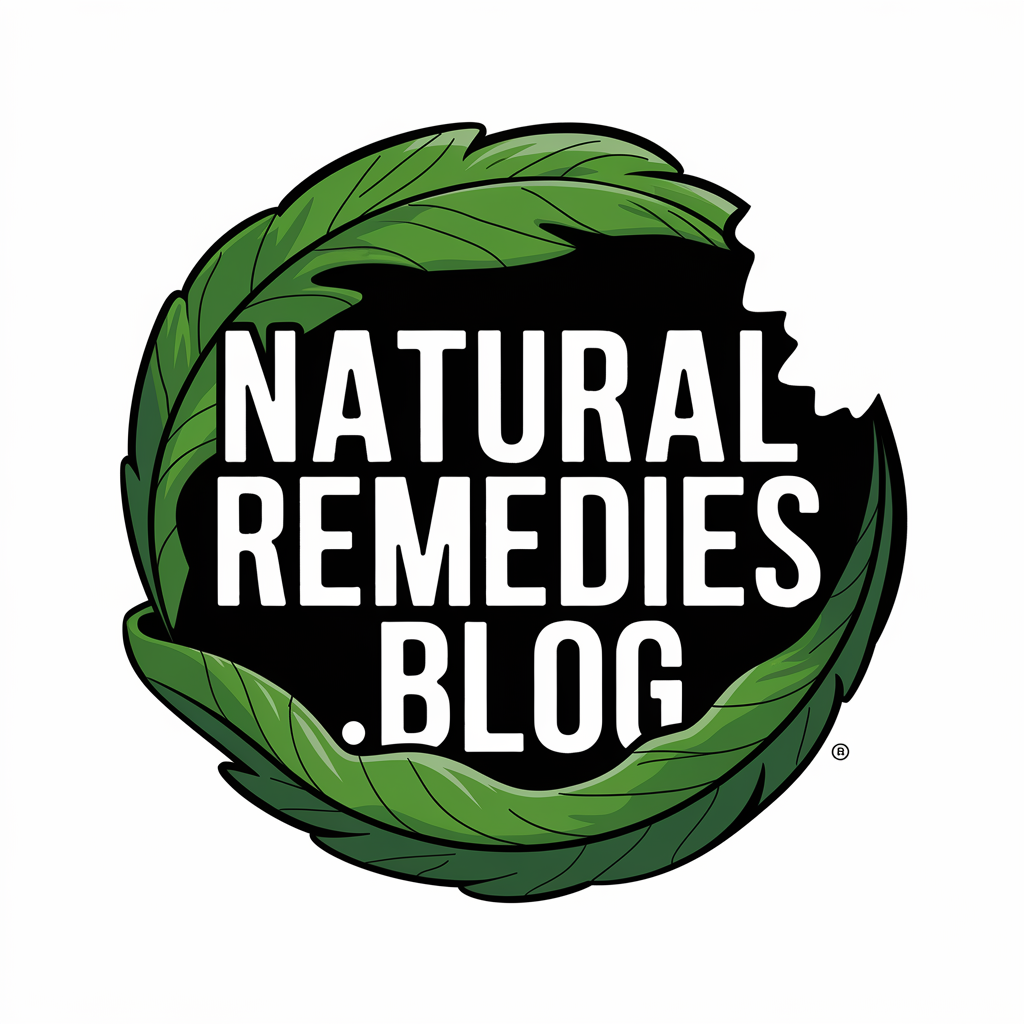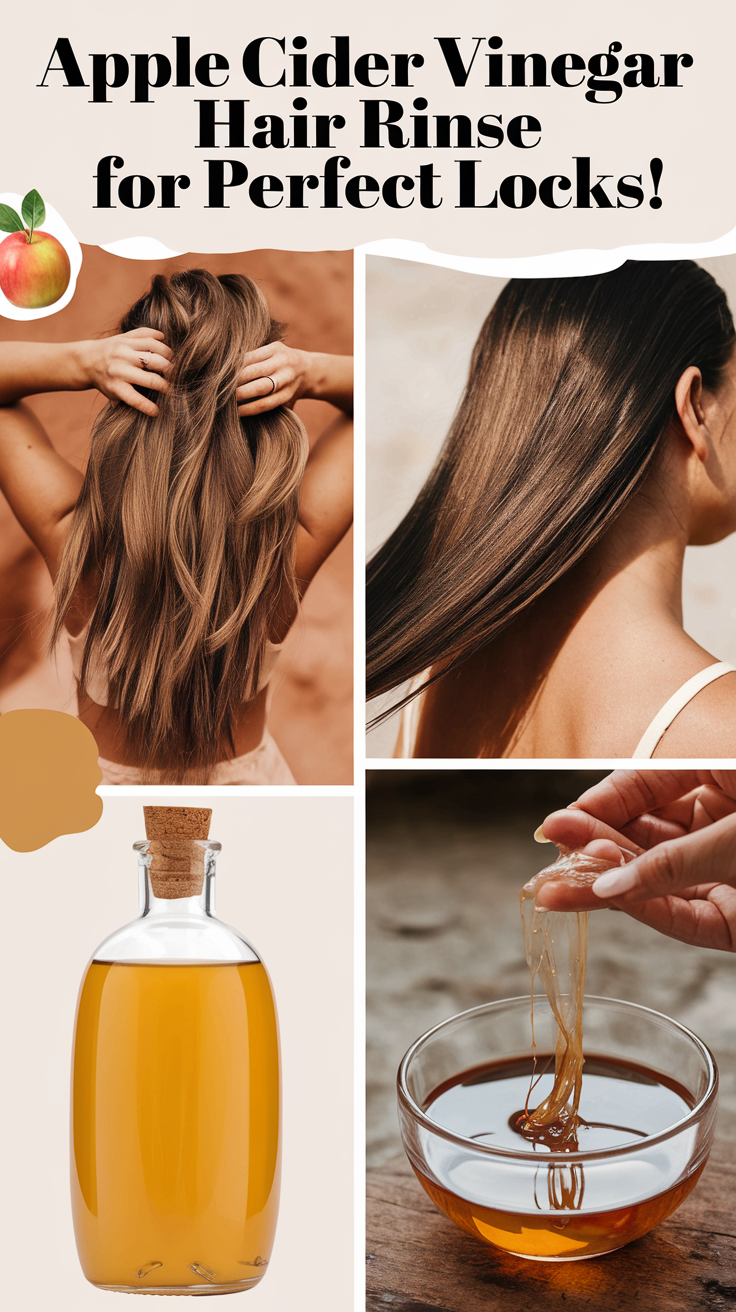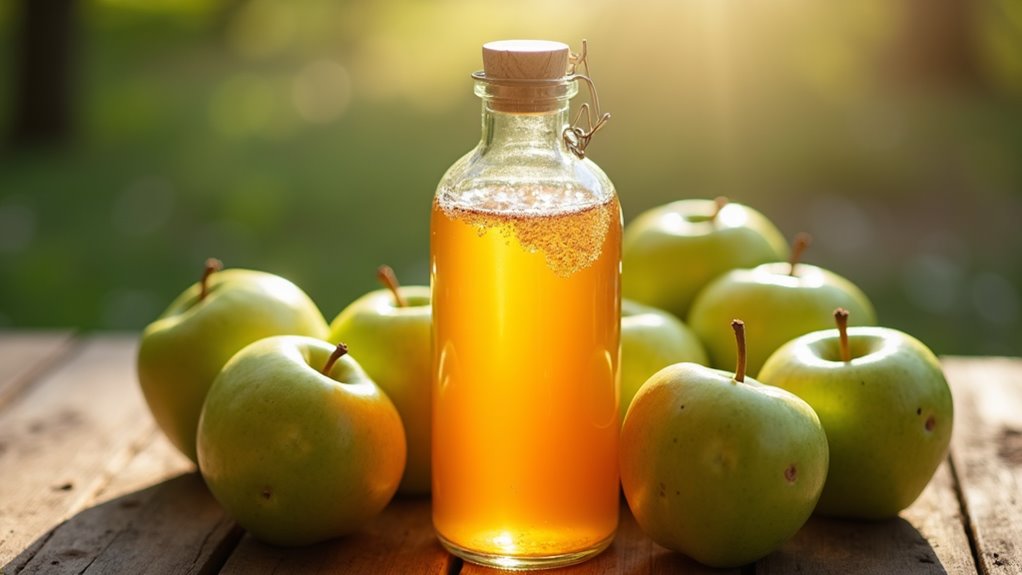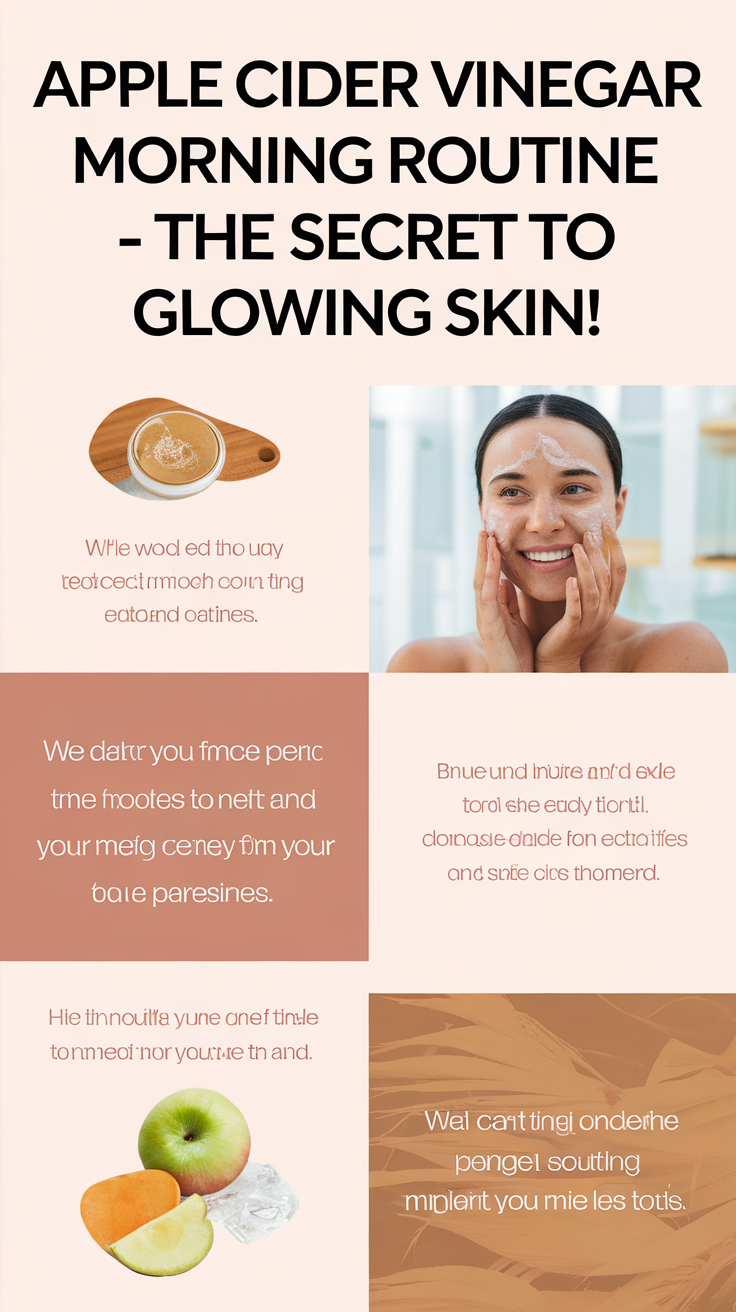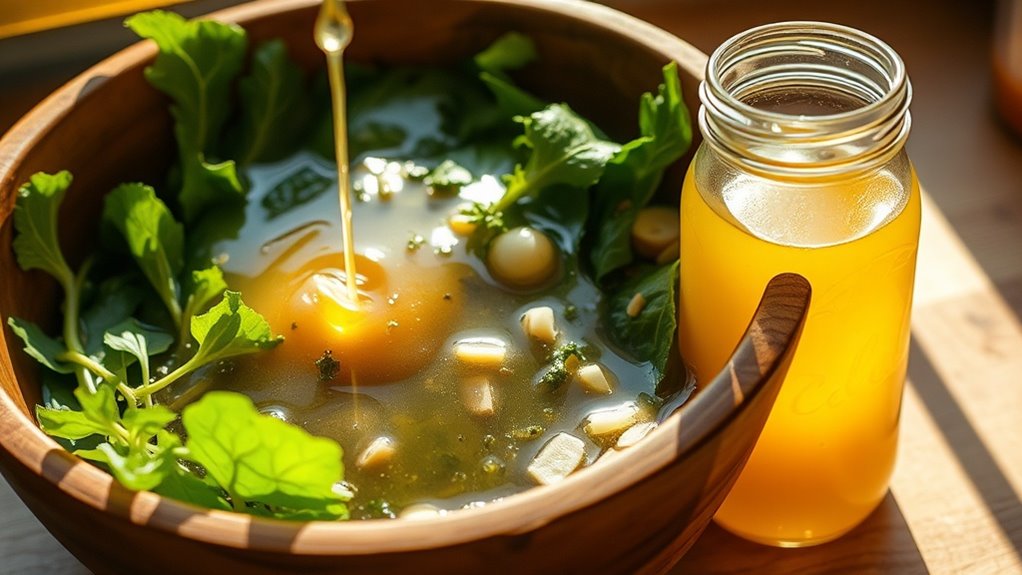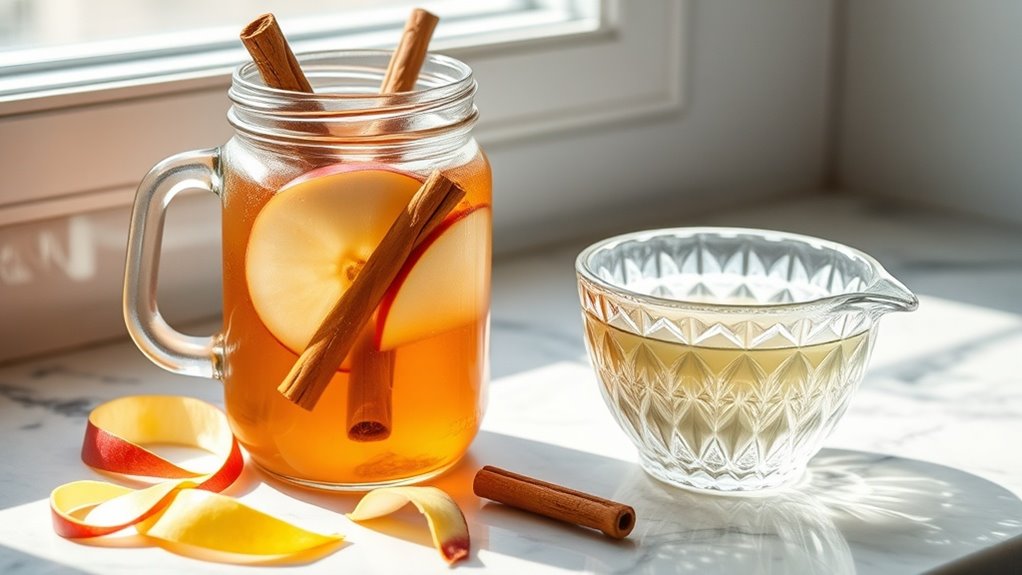Apple Cider Vinegar Hair Rinse for Perfect Locks!
Transform your dull hair into shiny, manageable locks with an apple cider vinegar (ACV) rinse. Mix 1 part raw, unfiltered ACV with 3 parts water and apply after shampooing once or twice weekly. ACV’s natural acetic acid balances your hair’s pH, removes buildup, and seals cuticles for smoother strands. You’ll notice immediate shine and less frizz, but the real magic happens when you discover how to maximize these benefits.
Key Takeaways
-
Mix 1 part apple cider vinegar with 3 parts water and apply after shampooing to restore hair’s natural pH balance.
-
Choose raw, unfiltered organic ACV with “the mother” for maximum benefits and store in a dark glass bottle.
-
Apply the rinse once or twice weekly, leaving it on for 3-5 minutes before thoroughly rinsing with cool water.
-
ACV rinses combat dandruff, reduce frizz, enhance shine, and remove product buildup while strengthening hair strands.
-
Results appear quickly, with improved shine after first use and healthier scalp conditions within 2-3 weeks of regular treatments.
What Makes Apple Cider Vinegar Special for Hair Care
While many natural ingredients can benefit your hair, apple cider vinegar stands out for its unique combination of properties.
It’s packed with acetic acid, which helps balance your scalp’s pH levels and removes buildup from styling products. When you use an apple cider vinegar hair rinse, you’ll join countless others who’ve discovered its natural cleansing power.
The magic lies in its antimicrobial properties that combat dandruff and scalp issues. Unlike harsh chemical products, it won’t strip your hair of its natural oils.
Instead, it seals your hair cuticles, resulting in smoother, shinier strands that are less prone to tangles and frizz. You’ll also love how it strengthens your hair shaft and stimulates blood flow to your scalp, promoting healthier hair growth.
The Science Behind ACV’s Hair Benefits
Because apple cider vinegar contains acetic acid with a pH level between 2.8 and 3, it naturally aligns with your hair’s ideal pH range of 3.5 to 5.5. When you use ACV, you’re helping to seal your hair’s cuticles, leading to smoother, shinier strands that reflect light better.
The antimicrobial properties of ACV work to combat scalp bacteria and fungi that can cause dandruff and itchiness. Its alpha-hydroxy acids gently exfoliate dead skin cells, while its vitamins B and C nourish your scalp.
You’ll also find that ACV’s natural clarifying abilities remove product buildup without stripping your hair’s natural oils. The potassium in ACV helps prevent split ends, while its enzymes strengthen your hair shaft from root to tip.
Essential Hair and Scalp Benefits
Regular use of apple cider vinegar hair rinse delivers multiple transformative benefits for both hair and scalp health.
You’ll notice your scalp becoming less itchy and flaky as ACV’s natural antifungal properties combat dandruff. The rinse’s acidic nature helps balance your scalp’s pH level, reducing excess oil production while maintaining necessary moisture.
Your hair will feel smoother and look shinier because ACV seals the hair cuticles, reducing frizz and preventing split ends.
You’ll love how it removes product buildup and mineral deposits from hard water, leaving your strands clean and manageable. Plus, the rinse stimulates blood circulation to your scalp, encouraging healthy hair growth.
If you’re dealing with hair fall, you’ll appreciate how ACV strengthens hair follicles and reduces breakage.
Understanding Your Hair’s Ph Balance
If you’ve ever wondered why your hair feels dull or unmanageable, the answer might lie in its pH balance. Your hair’s natural pH level sits between 4.5-5.5, making it slightly acidic. When you use products that disrupt this balance, you’ll notice changes in your hair’s texture and appearance.
| pH Level | Effect | Hair Condition |
|---|---|---|
| Too Acidic (<4.0) | Brittle & Dry | Breakage Prone |
| Balanced (4.5-5.5) | Smooth & Shiny | Healthy |
| Too Alkaline (>6.0) | Frizzy & Rough | Damaged |
That’s where apple cider vinegar comes in – it’s naturally acidic and helps restore your hair’s ideal pH balance. By incorporating an ACV rinse into your routine, you’re joining countless others who’ve discovered this natural way to maintain healthy, balanced hair.
Selecting the Right Apple Cider Vinegar
Choosing the right apple cider vinegar makes a significant difference in your hair care results.
You’ll want to select raw, unfiltered, organic ACV that contains “the mother” – those cloudy strands floating at the bottom that indicate beneficial enzymes and bacteria. Look for brands that are amber-colored and packaged in glass bottles to guarantee maximum potency.
Don’t be tempted by clear, filtered varieties that might cost less. These processed versions have lost many of the natural compounds that make ACV so effective for hair care.
Popular trusted brands like Bragg’s and Eden Foods offer high-quality options you can count on. When you’re shopping, check the label for words like “raw,” “unpasteurized,” and “with the mother” to guarantee you’re getting the most beneficial product for your hair rinse routine.
Basic ACV Hair Rinse Recipe
Creating the perfect ACV hair rinse starts with the right dilution ratio. Mix one part apple cider vinegar with three parts water in a clean spray bottle or cup. For most hair types, this 1:3 ratio works best, though you can adjust it based on your needs.
You’ll want to prepare enough mixture to thoroughly saturate your hair from roots to ends. For shoulder-length hair, combine 2 tablespoons of ACV with 6 tablespoons of water. If you have longer or thicker hair, double these measurements.
For added benefits, you can enhance your rinse with a few drops of essential oils like lavender or rosemary. Always shake the mixture well before each use, and store any leftover rinse in a cool, dark place for up to one week.
Additional Natural Ingredients to Enhance Your Rinse
While apple cider vinegar works well on its own, you can boost its effectiveness by incorporating natural ingredients into your rinse.
Add a few drops of rosemary essential oil to stimulate hair growth and combat dandruff, or mix in lavender oil for its calming scent and antimicrobial properties.
You’ll love how tea tree oil helps with scalp issues while lending a fresh, invigorating aroma.
For extra moisturizing benefits, blend in a tablespoon of raw honey or aloe vera gel.
If you’re dealing with dry scalp, try adding chamomile tea or green tea to soothe irritation.
Rose water can balance your scalp’s pH while adding a lovely fragrance.
These natural boosters won’t just enhance your hair care routine – they’ll transform your rinse into a spa-worthy treatment.
Step-by-Step Application Guide
To get the most from your apple cider vinegar rinse, proper application makes all the difference.
Start by mixing one part apple cider vinegar with three parts water in a clean spray bottle or applicator. After shampooing your hair, gently squeeze out excess water.
Section your damp hair into manageable parts and apply the mixture directly to your scalp, working your way down to the ends. Massage the solution into your scalp for 1-2 minutes, allowing it to penetrate.
Let the rinse sit for 3-5 minutes while you relax.
Finally, rinse your hair thoroughly with cool water to seal the cuticles and lock in shine.
Don’t worry about the vinegar smell – it’ll fade as your hair dries, leaving you with soft, balanced, and beautiful locks.
Best Timing and Frequency of Use
How often should you use an apple cider vinegar rinse? For most hair types, using it once or twice a week is ideal.
If you’ve got oily hair, you can safely use it up to three times weekly, while those with dry or color-treated hair should stick to once every two weeks.
The best time to apply your rinse is right after shampooing, when your hair needs rebalancing.
Don’t use it on days when you’re planning other chemical treatments or hair masks – your scalp needs time to recover between treatments.
During humid seasons, you might need it more frequently to combat frizz, while in winter, you’ll want to reduce usage to prevent dryness.
Just listen to your hair’s needs and adjust accordingly.
Tips for Different Hair Types
Different hair types respond uniquely to apple cider vinegar rinses, so you’ll need to adjust the dilution ratio and application method accordingly.
For fine or oily hair, use a more diluted mixture of 1 tablespoon vinegar to 1 cup water, applying it mainly to your scalp.
If you’ve got thick or coarse hair, try a stronger solution of 2-3 tablespoons vinegar per cup of water, focusing on both scalp and strands.
For curly hair, you’ll want to concentrate the rinse on your ends to fight frizz while maintaining your natural curl pattern.
Those with color-treated hair should stick to gentler ratios and less frequent applications to protect their investment.
If you have a sensitive scalp, start with the most diluted mixture and gradually increase the concentration if needed.
Common Mistakes to Avoid
While apple cider vinegar rinses offer many benefits, several common mistakes can reduce their effectiveness or even damage your hair.
Don’t use undiluted vinegar, as it’s too acidic and can irritate your scalp. Skip using metal bowls or containers, since they can react with the vinegar and alter its properties.
Never leave the solution on your hair for more than 5 minutes, as prolonged exposure may cause dryness.
Avoid applying the rinse to your hair more than twice a week, which can disrupt your scalp’s natural pH balance.
Don’t forget to thoroughly rinse your hair with cool water afterward to seal the cuticles.
Finally, resist the urge to use hot vinegar solutions or apply the rinse to unwashed, product-filled hair, as both practices can diminish the treatment’s benefits.
Storage and Shelf Life
Properly storing your apple cider vinegar hair rinse solution can extend its effectiveness and prevent contamination. Keep your mixture in an airtight, dark-colored glass bottle away from direct sunlight and heat. A bathroom cabinet or cool, dry shelf works perfectly for this purpose.
If you’ve made a diluted solution, it’s best to use it within 2-3 weeks. You’ll want to watch for any unusual changes in smell, color, or consistency.
For longer storage, keep your apple cider vinegar undiluted in its original bottle, then mix your rinse fresh when needed. The undiluted vinegar typically lasts up to 2 years when stored correctly.
Remember to label your bottle with the mixing date and ratio – you’ll thank yourself later!
Always give the bottle a gentle shake before each use.
Combining ACV With Other Hair Treatments
Apple cider vinegar hair rinses can complement many of your existing hair care products and treatments when used strategically.
You’ll get the best results by combining ACV with natural ingredients like coconut oil, honey, or aloe vera. Mix these ingredients into your rinse to create a customized treatment that addresses multiple hair concerns at once.
Don’t hesitate to incorporate ACV into your regular hair care routine. You can use it before your shampoo to remove buildup, after conditioning to seal the cuticle, or between other treatments to balance your scalp’s pH.
For deep conditioning treatments, apply your mask first, then follow with an ACV rinse to lock in the benefits. Just remember to space out protein treatments and ACV rinses by at least 24 hours to avoid overwhelming your hair.
Signs Your Hair Needs an ACV Rinse
If you’re wondering whether your hair could benefit from an ACV rinse, several telltale signs can indicate it’s time for a treatment. Your scalp might feel itchy and flaky, or your hair may appear dull and lifeless.
Product buildup often leaves your strands feeling waxy and heavy, even right after washing.
Watch out for hair that’s become difficult to detangle or feels unusually brittle. If you’re noticing increased frizz or your regular styling products aren’t working as well anymore, your hair’s pH balance might be off.
Another clear indicator is when your scalp feels oily shortly after washing, while your ends remain dry and stressed. These common issues signal that your hair’s ready for the clarifying and balancing effects of an ACV rinse.
Expected Results and Timeline
Most users notice initial improvements from an ACV rinse after the first treatment.
You’ll likely experience immediate shine, decreased frizz, and hair that feels cleaner and lighter. Your scalp may feel less itchy and more balanced within 24 hours.
For lasting results, you’ll want to incorporate ACV rinses into your regular hair care routine.
After 2-3 weeks of weekly treatments, you can expect considerably less buildup, balanced pH levels, and healthier-looking hair. Your strands will become more manageable, and you might notice reduced dandruff and fewer split ends.
Long-term users report stronger hair growth, enhanced natural curl patterns, and restored scalp health after 2-3 months of consistent use.
Remember that everyone’s hair responds differently, so adjust the frequency of treatments based on your hair’s needs.
Before and After Hair Care Routine
To get the most from your ACV rinse treatment, you’ll need to follow proper preparation and aftercare steps.
Before applying the rinse, thoroughly shampoo your hair to remove buildup and open the cuticles. Don’t condition your hair yet – save that for after the treatment.
After applying your ACV rinse, let it sit for 3-5 minutes, then rinse thoroughly with cool water to seal the cuticles.
Follow up with your regular conditioner, focusing on the mid-lengths and ends. Style your hair as usual, but avoid heat tools for the next 24 hours to maximize the treatment’s benefits.
You’ll notice your hair feels smoother and looks shinier right away. Join thousands of others who’ve made ACV rinses part of their weekly hair care ritual.
Troubleshooting Common Issues
While the ACV hair rinse process is straightforward, you might encounter some challenges along the way.
If you’re experiencing a strong vinegar smell that lingers, try diluting your mixture with more water or adding a few drops of essential oils.
When your scalp feels itchy or irritated, reduce the frequency of your rinses to once a week or decrease the ACV concentration.
Notice your hair feeling dry or brittle? You might be using too much vinegar or leaving the solution on for too long. Adjust your ratio to 1 part ACV to 4 parts water, and don’t exceed 3-5 minutes of contact time.
If you’re getting vinegar in your eyes, tilt your head back during application and use a shower cap to control the solution’s flow.
Safety Precautions and Considerations
Before incorporating an ACV rinse into your hair care routine, you’ll need to evaluate several important safety measures.
Never use undiluted ACV directly on your scalp, as it can cause chemical burns and irritation. If you have sensitive skin or open wounds, it’s best to skip the treatment until you’ve healed.
Always protect your eyes during application – if contact occurs, rinse immediately with clean water for 15 minutes.
You’ll want to do a patch test 24 hours before your first full treatment to check for adverse reactions. If you color your hair, wait at least 48 hours after dyeing before using an ACV rinse.
Don’t overuse the treatment – once or twice a week is plenty for most people, as excessive use can disrupt your scalp’s natural pH balance.
Frequently Asked Questions
Can I Use Apple Cider Vinegar Hair Rinse During Pregnancy?
You’ll want to check with your doctor before using apple cider vinegar rinses during pregnancy, though they’re generally safe. Many moms-to-be enjoy this natural hair care option.
Will ACV Rinse Affect My Recent Hair Color or Highlights?
You’ll want to wait 2-3 weeks after coloring before using ACV rinses. While it’s generally safe, frequent use can gradually fade your color or highlights over time.
Can Children Safely Use Apple Cider Vinegar Hair Rinses?
You can safely use ACV rinses on children’s hair, but make sure it’s diluted (1 part vinegar to 5 parts water). Don’t let it get in their eyes and always supervise the process.
Does Apple Cider Vinegar Hair Rinse Help With Head Lice?
While you’ll find many home remedies for lice, apple cider vinegar isn’t proven to kill them. It might loosen nits, but you’ll need proper medicated treatments for effective lice removal.
Can I Use ACV Rinse Right After Getting a Keratin Treatment?
You shouldn’t use ACV rinse after keratin treatment – it’ll strip away the treatment you just paid for. Wait at least 2 weeks before using any acidic products on your treated hair.
